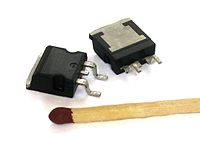
Photo from wikipedia
Abstract Conducting polymers (CP) are very versatile materials with important properties due to their unique structure, including redox behaviour upon electrochemical polarization. Supercapacitors are among the devices in which CP… Click to show full abstract
Abstract Conducting polymers (CP) are very versatile materials with important properties due to their unique structure, including redox behaviour upon electrochemical polarization. Supercapacitors are among the devices in which CP show a promising performance due to their large specific capacitance. However, the major drawback of these materials is their low durability, which is an inbuilt process caused by ion intercalation, a side effect of the redox process. A viable strategy to increase CP stability is, therefore, the inhibition of the ion intercalation/de-intercalation process. Several strategies have been proposed to minimize this effect, among them self-doping. Self-doping makes the redox process mass-transport independent, decreasing the response time and increasing durability. With this purpose, this work have described the synthesis of layer-by-layer films (LBL) of poly(o-methoxyaniline)/poly(3-thiopheneacetic acid) (POMA/PTAA) and contributes to understand how the redox process leads to premature aging, and how self-doping minimizes this problem. The main techniques of characterisation used were electrochemical impedance spectroscopy (EIS) experiments and density functional theory (DFT) calculations. EIS provides important information about the electrochemical behaviour, while DFT calculations allowed to characterize, at the molecular level, the changes in the material structure. The association of both techniques helped to understand how self-doping improves the POMA properties. DFT calculations showed that in the layer-by-layer (LBL) films, the twisting of the polymer chain due to the oxidation is 12% less while the chain shortening is 5% compared with films prepared POMA by casting . The EIS data showed the effect of these molecular changes in the structure; the swelling of the LBL films is 50% less than cast ones. These observations are important because the PTAA layer acts beyond a charge-compensator, working as a backbone structure that mechanically stabilize the POMA layer, leading to an increase in the durability, and improving the electrochemical properties.
Journal Title: Electrochimica Acta
Year Published: 2017
Link to full text (if available)
Share on Social Media: Sign Up to like & get
recommendations!